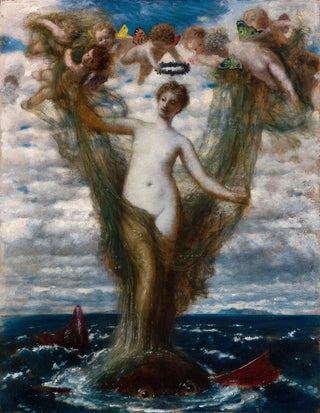Art print | Venus Anadyomene - Arnold Böcklin


View from behind

Frame (optional)
In the vast panorama of art history, some works manage to transcend their era to touch on the universal. "Venus Anadyomene" by Arnold Böcklin is undoubtedly one of these creations. Painted at the end of the 19th century, it evokes timeless beauty and the sensuality of the goddess of love, Venus, emerging from the waves. This representation, both mythological and deeply human, captivates the viewer with its elegance and poetry. The scene, bathed in light and delicate colors, invites contemplation that goes beyond mere observation. It embodies harmony between nature and spirit, offering a window into the artist's soul and the aesthetic aspirations of his time.
Style and uniqueness of the work
Böcklin's style is distinguished by its ability to fuse realism and symbolism, creating an atmosphere that is both tangible and dreamlike. In "Venus Anadyomene," the goddess is depicted in a moment of grace, delicately floating on the waves. The meticulous details of her wet hair, as well as the fluidity of her body, demonstrate remarkable technical mastery. The pastel tones, blending shades of blue, pink, and white, contribute to the sense of serenity emanating from the piece. Every element, from the movement of the waters to Venus's posture, is carefully orchestrated to evoke a feeling of softness and beauty. This work does not merely depict a mythological subject; it becomes a celebration of feminine beauty and nature, an ode to life.
The artist and his influence
Arnold Böcklin, Swiss painter, is often regarded as one of the pioneers of symbolism. His artistic vision, marked by a fascination with mystery and imagination, has left an indelible mark on the art world. Through his works, Böcklin explores themes such as mythology, death, and nature, creating universes where reality and the fantastic meet. "Venus Anadyomene" is part of this quest

Matte finish

View from behind

Frame (optional)
In the vast panorama of art history, some works manage to transcend their era to touch on the universal. "Venus Anadyomene" by Arnold Böcklin is undoubtedly one of these creations. Painted at the end of the 19th century, it evokes timeless beauty and the sensuality of the goddess of love, Venus, emerging from the waves. This representation, both mythological and deeply human, captivates the viewer with its elegance and poetry. The scene, bathed in light and delicate colors, invites contemplation that goes beyond mere observation. It embodies harmony between nature and spirit, offering a window into the artist's soul and the aesthetic aspirations of his time.
Style and uniqueness of the work
Böcklin's style is distinguished by its ability to fuse realism and symbolism, creating an atmosphere that is both tangible and dreamlike. In "Venus Anadyomene," the goddess is depicted in a moment of grace, delicately floating on the waves. The meticulous details of her wet hair, as well as the fluidity of her body, demonstrate remarkable technical mastery. The pastel tones, blending shades of blue, pink, and white, contribute to the sense of serenity emanating from the piece. Every element, from the movement of the waters to Venus's posture, is carefully orchestrated to evoke a feeling of softness and beauty. This work does not merely depict a mythological subject; it becomes a celebration of feminine beauty and nature, an ode to life.
The artist and his influence
Arnold Böcklin, Swiss painter, is often regarded as one of the pioneers of symbolism. His artistic vision, marked by a fascination with mystery and imagination, has left an indelible mark on the art world. Through his works, Böcklin explores themes such as mythology, death, and nature, creating universes where reality and the fantastic meet. "Venus Anadyomene" is part of this quest






